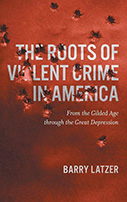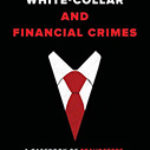The Roots Of Violent Crime In America: From The Gilded Age Through The Great Depression

Author: Barry Latzer
Publisher: Baton Rouge: Louisiana State University Press, 2020
Reviewer: Amikam Harpaz | September 2021
Writing a history of crime incorporating criminological research entails complex challenges, as one must try to understand past criminal behavior based on partial information. Criminological analysis is relatively recent, going back about two hundred years, and orderly and standardized data on crime are available to researchers only from the beginning of the twentieth century. Data from earlier periods are partial and even contradictory.
Another challenge, as far as a distinctly immigrant country like the United States is concerned, is understanding criminal behavior and its origins among immigrant, local and indigenous cultures without entering the minefield of political correctness.
Finally, one should address the relationship between economics and crime, especially the role of poverty as a correlate of crime. This is a particularly relevant question in a country like the United States where the economic system has brought it to the forefront of developed countries, but at the heavy cost of many being thrown under the bus.
Various theories attribute crime to poor social conditions – poverty, unemployment, inadequate housing, and the like. Here, Barry Latzer confronts these explanations and argues that while they are not entirely incorrect, they do not provide sufficient evidence for understanding the phenomenon of crime. Consequently, he offers a different view of this phenomenon – the subculture of violence thesis.
The Roots of Violent Crime in America succeeds with all of these challenges. The writing is fluent; mastery of the relevant sources is evident; and the interpretation, though controversial, is sensitive to the issues raised by the subject of crime and society. The book focuses on violent crime in the United States between 1880 and 1940, a period in which the country experienced great waves of migration and periods of sharp economic ups and downs, most notably the Great Depression of the 1930s.
One of the common denominators of the waves of immigration from various countries throughout the period under review is poverty, because the bulk of immigrants to the United States arrived destitute. Had the explanation for violent crime been based primarily on poverty, we would have expected similar violence rates among the various immigrant cultures. But in fact, Latzer found that the rates of violence among impoverished immigrants from Germany and the Scandinavian countries, for example, were significantly lower than the crime rates of immigrants from Italy and Ireland.
His main argument is that some immigrant groups have brought with them to the United States a subculture of violence, and this is true not only of immigrants coming from other countries, but also of internal migrants within the United States itself. A prominent example of the adoption of a subculture of violence is that of the African Americans who internalized it from the white inhabitants of the southern states. One of the salient features of white society in the South was the “culture of honor,” which Latzer sees as instrumental in the development of the black subculture of violence.
This book is divided into six parts encompassing eleven chapters. The first part discusses the culture of violence that characterized the southern states; the second depicts the violence in the “Wild West,” a concept familiar from the field of the Western genre. The third part discusses whether there is a link between urban poverty and violent crime. The fourth deals with the importation of violent crime by immigrants, and in particular examines the violent crime brought to the United States by Italians and European Jews on the one hand, and by Mexicans on the other. The fifth part deals with the violence of criminal organizations, especially during the Prohibition era. The last part focuses on the relation between the economy and violent crime, particularly during the 1930s, when the United States was plunged into a deep economic depression.
The southern states had the highest rates of violence of any region in the United States. In 1877 and 1878, for instance, the homicide rate in South Carolina was 12 times higher than in Massachusetts. The economies of the southern states relied mainly on agriculture; therefore these were mostly rural states. This fact is itself of interest because it is common to assume that violent crime is primarily an urban phenomenon. Moreover, in the southern states, the violence crossed class lines and was thus not only the domain of the lower class, as is usually assumed. Duels over matters of honor were very common among the upper class. Finally, though some immigrant groups brought violence to the United States, in the South, which had low numbers of foreign entrants, the bulk of the violence was native.
One oft stated reason for the high rates of violent crime in the South was that the southern courts’ treatment of violent offenders was much more lenient than its comparable treatment of property offenders. According to Latzer, this actually was not the principal reason. Nor was it mainly because of poverty or urbanization (which was not significant in the South), or because of slavery or the mentality of the frontier. Instead, he argues, violence in the South was part of the so-called “redneck” culture (a derogatory expression for uneducated southerners), which only recently began to loosen its grip. As a result, white violence in the South remained high not only in the nineteenth century, but even for most of the twentieth.
Towards the end of the nineteenth century, the level of violent crime among African Americans rose sharply, initially in the southern states, where a majority of Blacks resided. Latzer points out that law enforcement systems in the South, which generated the data indicating high levels of Black crime, discriminated against African Americans in arrests, trials and punishments. This bias led to many more guilty verdicts and longer sentences for Blacks than for whites. So, he says, these data must be viewed with suspicion.
There also began, in the late nineteenth century, a great Black migration to the North. The increase in the number of Blacks in the northern states was the result of many developments, including the results of the Civil War, — one impact of which was economic. The war wreaked havoc on agricultural production in the southern states, forcing many Blacks to abandon the South in search of employment in the more industrially developed North. Industrial employment opportunities and Black migration became especially pronounced around World War I.
These waves of internal migration created impoverished and high-crime Black ghettos in the North. Latzer offers two different explanations of the source of high violent crime among Blacks in the North. It is possible, he submits, that violent crime was a result of the conditions of urban poverty in the ghettos. Alternatively, he suggests, the values of violent crime from the South migrated along with the African American travelers. In raising doubts about poverty as a primary explanation for violent crime, he suggests that the “culture of honor” has more explanatory power both for whites and Blacks. Summarizing the sources of the increase in Black violent crime at the end of the nineteenth century, he claims that the “culture of honor” Blacks learned from whites in the South, plus the increase in the availability of firearms, contributed the most to the violent crime among them.
In the northern cities, the level of violent Black crime far exceeded that in the South. In Chicago, for example, the homicide rate in the African American community in 1925 was nine times greater than that among whites. The 1920s were good years economically, so the economic explanation as a cause of crime seems flawed. What then is the better explanation? According to Latzer, the rich northern cities offered far more opportunities to commit violent crimes, especially robbery offenses.
Part two of the book focuses on violent crime in the “Wild West” — linked in popular culture with many legends, stories and movies. Chronologically, this section is mainly about the three decades of the second half of the nineteenth century, as towards the fin de siècle, the so-called Wild West was largely tamed. There are various reasons for the violent crime here, some related to the fact that a large part of the population was made up of young male job seekers concentrated in mining towns and cattle towns; some related to the violent subculture that was imported with immigrants such as Italians and Mexicans who went west for employment; and some related to the violence of indigenous peoples (Native Americans). A large proportion of homicides could be attributed to minor conflicts that were not successfully resolved. The post-Civil War period was characterized by the weakness of the law enforcement apparatuses and the lack of effective governance. According to Latzer, the lack of orderly political mechanisms and the lack of peaceful conflict resolution mechanisms contributed significantly to the violent crime of the West.
The third part of Roots of Violent Crime is devoted to an important question about the relationship between urbanization and crime. The plight of several major U. S. cities in the last decades of the nineteenth and early twentieth centuries is reviewed, including New York, Chicago, Los Angeles and San Francisco. Major American cities experienced a dramatic increase in population towards the end of the nineteenth century, an increase accompanied by economic hardship, including poor housing and meager livelihoods. School dropouts among children over the age of 12 were very common due to economic adversity and some, due to this adversity, turned to crime. At the same time, the political mechanisms were mired in corruption, and the police were also tainted by corruption and lack of professionalism.
The author tries to address a number of questions about the trends of violent crime in the late nineteenth century, including why there was a decline in crime towards the end of the century, and why violent crimes such as robbery, rape and homicide were not so common despite the criminogenic conditions. To answer the first question, Latzer notes that the huge waves of German, Scandinavian, and Jewish immigrants arriving at the end of the nineteenth century did not carry with them violent subcultures. Regarding the second question, he points out that violent crime in the nineteenth century was usually characterized by a familiarity between the victim and the perpetrator. By contrast, violent crime of the late twentieth century in U.S. cities was characterized by the randomness of the victimization. Almost anyone could fall victim to a violent crime — a fact that contributed greatly to raising fear of crime, increasing seclusion and the taking of strict security measures. Latzer attributes the rise of stranger crime to technological advances such as vehicle use, the widespread proliferation of firearms, especially handguns, and multiple attractive targets in the big city.
Part four of the book deals with the relation between immigration and violent crime in the late nineteenth and early twentieth centuries. At the center of the discussion is a comparison between two immigrant groups: the Italians and the Jews. Latzer shows how much Italian immigration, especially from southern Italy and Sicily, has contributed to violent crime, relative to Jewish immigrants and other immigrant cultures, including those of German and Scandinavian descent. He rejects ethnic bias as the main explanation for violent crime among immigrants, but believes that among African Americans the influence of these attitudes was felt most acutely, albeit indirectly: racism prevented Blacks from advancing to the middle-class, and membership in the middle-class is associated with less violent crime. But because bias did not prevent members of particular immigrant communities from advancing up the economic/social ladder, their crime rates actually declined as they became more affluent.
A group of immigrants different from those who came from Europe and Asia were the Mexicans, who crossed the border into the United States because of political instability in Mexico in the early twentieth century. This led to a tenfold jump in their immigration numbers between 1910 and 1930. The behavior patterns of Mexicans were different from other immigrant groups, as most of them intended to improve their economic situation and return to Mexico. However, even in the case of the Mexicans, the cultural explanation plays an important role because the violent crime among them was directed mainly towards other Mexicans, stemming in part from the violent subculture that was common in their former homeland.
Section five examines crime during the prohibition period from 1920 to 1933, when the ban on alcohol was abolished. Latzer opens the discussion with a somewhat surprising statement, that despite the wars among bootleggers that drove up the rates of homicide in big cities, the fact is that overall, prohibition did not cause a huge rise in crime rates during the 1920s. He reviews the historical background that preceded the prohibition regulations, including data on alcohol consumption, the contribution of conscription in World War I, as well as the impact of the Spanish flu epidemic. He concludes that prohibition regulations actually drove down crime by reducing alcohol consumption (due to the increased cost of alcoholic beverages), as well as by shutting down the saloons – a salient greenhouse of violent offences.
There was an increase in levels of violent crime during the early years of the depression, but that was followed by a decline in crime in the later years, which raises questions about crime’s relationship to the economy. Latzer points out that there were non-economic explanations for the crime fall in the late 1930s, such as the sharp decline in immigration to the United States, reductions in the internal migration of African Americans from southern states to northern cities, and programs launched by the Roosevelt administration, especially those targeting young people. He concludes this discussion by arguing that violent crimes such as homicide, rape and assault are not necessarily related to unemployment.
In concluding his book, Latzer argues that the main contributing factor to violent crime in America has been the criminal subculture brought by certain immigrants and internal migrants, while any role played by the law enforcement system was secondary. He ends, however, on an optimistic note, arguing that as groups with a violent subculture rise up on the socio/economic ladder, the levels of violent crime among them decreases. These results have already been seen among African Americans whose crime rates declined significantly in the 1990s, in part due to the rise of a Black middle class in the wake of the civil rights movement.
The term “violent subculture” is central to the thesis presented by Latzer in explaining the high crime rate within various communities in the United States. This explanation largely exempts the heavy responsibility of the law enforcement system in crime prevention, and especially that of the police. Latzer does point a blaming finger at law enforcement agencies that at various times treated immigrants and others, especially African Americans, with extreme severity while using racial and ethnic profiling practices. But this is presented as only very much a secondary factor in explaining violent crime. I wish this book had included a more thorough discussion of the role of American police in dealing with crime. But what is more important is that this book is a wake-up call to every multi-cultural society to promote equal opportunities for advancement up the socio-economic ladder, lest otherwise populist prejudices continue to prevail and to support subcultures of violence, in a kind of vicious circle.
Amikam Harpaz, The Hebrew University of Jerusalem, Institute of Criminology


